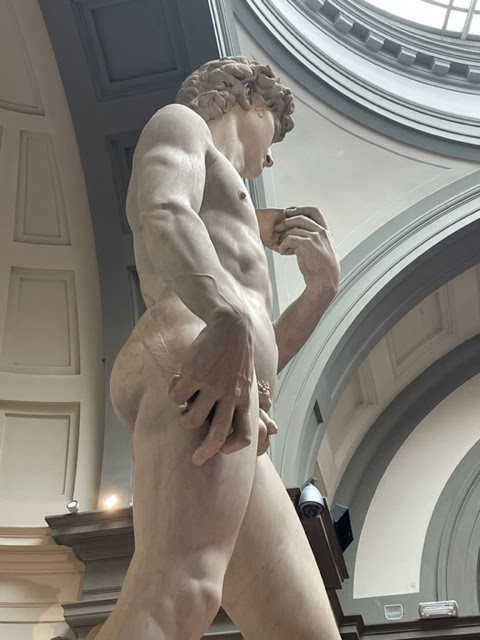"Did you see Michelangelo's David?""
That is a question I was asked several times after my return from Florence last month. It's an interesting question because it seems to imply that if you hadn't then you hadn't really been to Florence. Or, to put it another way, that David is the reason to go to Florence in the first place, as if the Uffizi, the Bargello, Palazzo Pitti and everything else is as nothing.
If you plan to go to Florence, it's useful to know that Michelangelo's David--the authentic one, not the replica--resides at the Galleria dell'Accademia. The Accademia is home to many treasures, but for certain David has the place of centrality here, and it is breathtaking.
There are a variety of stories that swirl about in my head when I think on this statue. First, there is the story about how it came to exist. Then there are the stories of what it means as a symbol. Why David? And finally, the stunning magnificence of young Michelangelo's David as a work of art in and of itself.
Here's a little backstory. Michelangelo was only 26 when he carved this statue out of a single block of marble. The 17-foot-high block was considered to be of inferior quality with little value according to the master craftsmen of his day. "Give it to the kid," you can imagine one of them saying as peers laughed.
When they saw what the young artist had produced with this throwaway stone, no one was laughing. To this day, people stop in their tracks when the David comes into view. They draw near with eyes wide, mouths agape. With well-defined muscles, expressive face, perfectly proportioned body, the David captures something of the Renaissance spirit of determination and courage, strength and resilience. When you stand up close, you can even see the veins in his arm.
David was one of the most significant characters in the Old Testament. Michelangelo chosen to focus on a singular turning point in David's life, his battle with the giant Goliath. Up till that moment he was a shepherd. True, he had killed powerful predators, including a lion, to protect his sheep and was no novice when it came to fighting adversaries. This was different. He was going face to face with a professional soldier, and a giant one at that. (You can read the story of this confrontation in I Samuel 17:26-50.)
 |
| Note the muscles, tendons and veins in the arm. |
David's confidence in the face of seemingly overwhelming odds, made him a symbol of hope and inspiration.*
The room where David has been placed is called the Sala Del David. It's a large rectangular room with a high arched ceiling where a dome of windows allows diffused light to filter in from above. The statue of David is located in the center of the room, on a raised pedestal, making it even more imposing. The manner in which the light flows in helps to highlight the details. The location enables visitors to view it from all sides. There are also benches along the wall behind it where one can take a seat and reflect on it.
When you first enter the Accademia the corridor is lined with statues on the left and right, six by Michelangelo. These are variations on the theme of characters breaking out of their rock enclosures. They are essentially unfinished works that have been preserved to show how the artist chipped his characters out of their confines.
EdNote: Before traveling to Italy I did spent a couple months in planning my trip. I was greatly helped by Rick Steves Pocket Florence, which I purchased after deciding what cities I would be visiting on this adventure. What I learned is that to avoid lengthy lines one is at advantage by purchasing tickets in advance. There were two lines outside the entrance. One was for people who did not buy a ticket in advance. That line stretched around the corner. The line I was in had six or eight people in it.
Michelangelo's David isn't the only Renaissance masterpiece in Florence. This city filled with an overabundance of awe-inspiring art and architecture. Even though I was brain-numbed by all I'd seen beforehand, the site of this David struck me with unexpected force.
* * * *
*David's significance extended far beyond the slaying of Goliath. In addition to being Israel's second king, he wrote many of the Psalms. There's a sense in which he was like a real life. action hero. He was a complex man who made mistakes but was deeply devoted to God. There's evidence outside of the Bible that David was an actual historical figure who lived about a thousand years before Christ.



No comments:
Post a Comment